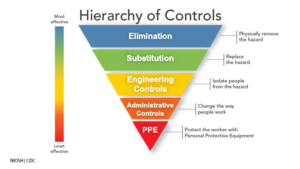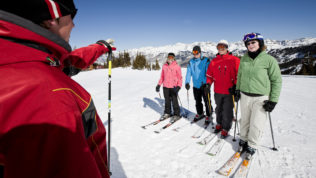In both our business and personal lives, risk is unavoidable. But accepting risk needn’t be “all or nothing.” You have options for mitigating an identified risk, and the same principles you might use in assessing a business risk can be used in your personal life.
PHASES OF RISK MANAGEMENT
Phase 1 of the risk management process is to identify risks. Phase 2 is to analyze options for risk control.
With cold weather approaching, outdoor winter sports are on our mind. However, these activities present an inherent risk. Take, for example, snow skiing. Is dusting off the skis and hitting the slopes worth the risk of a potentially severe injury?
Applying the Occupational Safety and Health Administration’s Hierarchy of Controls may help you analyze the options and make skiing a safer experience.
ELIMINATION OR AVOIDANCE

If your professional and personal lives will not support injury recovery, total risk avoidance may be the best option. If you desire to accept the risk associated with skiing, consider these avoidance tactics:
- Select a resort commensurate with your competence. Taking on the mountains of Colorado after skiing in the Midwest a decade ago may not be the best option.
- Ride the green or blue runs and avoid those marked Black Diamond.
- Stay in the lodge by the warm fire drinking hot chocolate while watching other skiers.
- If the weather forecast looks threatening, stay home.
SUBSTITUTION
A full day of downhill skiing is not the only option. If you are seriously concerned with the potential for injury, consider these other options:
- Cross-country skiing
- Tubing
- A half-day pass
ENGINEERING CONTROLS
My husband was once teased for using the throw-back long, slender K2 skis. Not only were they dated, these skis may no longer be the safest option. Before racing to the resort, be sure to:
- Service equipment
- Ensure proper fit and size
- Use the safety bar when on chairlifts
- Research advanced safety features
- Replace old and damaged equipment
ADMINISTRATIVE CONTROLS
Every season brings a fatality from either a backcountry skier subject to an avalanche or skiers who collide with one another or a tree. Pay attention to the warnings and these tips:
- Learn the terrain
- Take lessons if you are uncomfortably rusty
- Apply the rules of skiing, being courteous to other skiers
- Read and obey the signs
PERSONAL PROTECTIVE EQUIPMENT
Personal protective equipment is not going to prevent an incident from happening; however, it may minimize the impact. Older skiers did not grow up wearing helmets, which are now commonly seen on the slopes and should be worn. Proper clothing and eyewear are especially important when subject to winter weather.
These controls are in order of most- to least-preferred but are not mutually exclusive. Consider one control or a combination and implement.
Accepting any of life’s risks is most often worth the benefit. Knowing the risk assessment process will help you do so safely. Enjoy!
This loss control information is advisory only. The author assumes no responsibility for management or control of loss control activities. Not all exposures are identified in this article. Contact Landmark Risk Management & Insurance for coverage advice and policy service.

